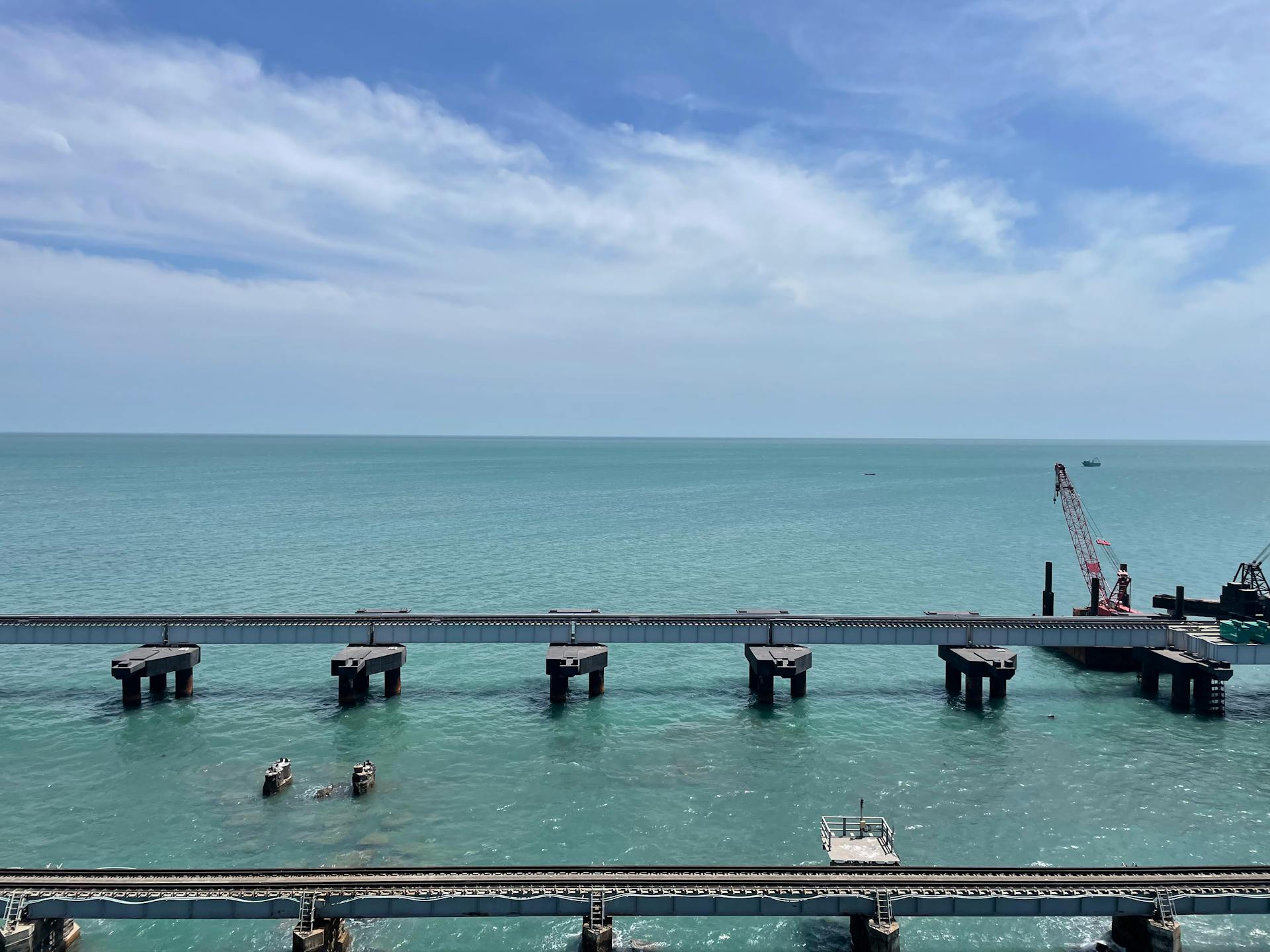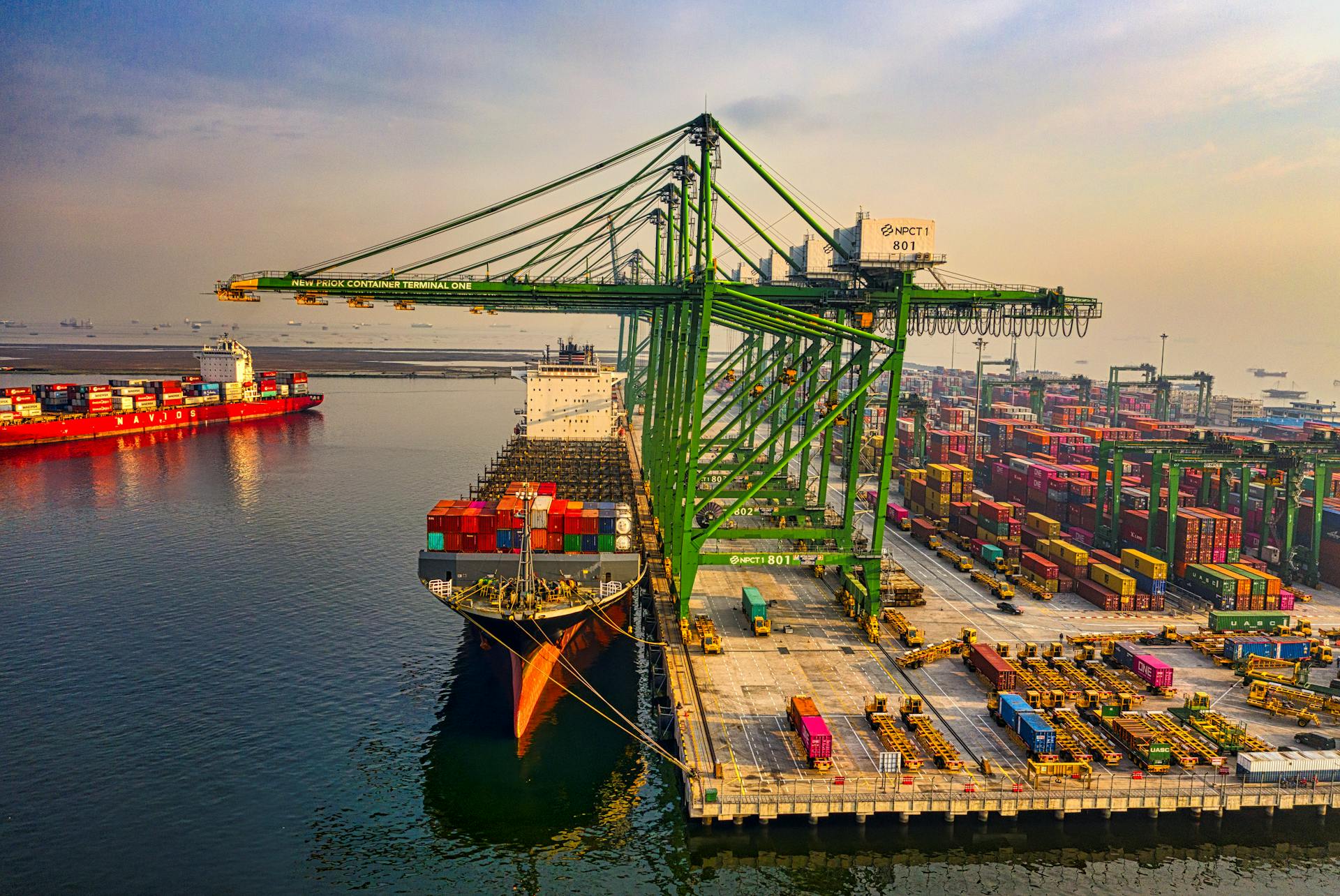
The East India Docks have a rich history that spans over two centuries. Construction on the docks began in 1806 and was completed in 1815.
The docks were designed to handle the growing trade between Britain and its colonies in India. They were strategically located near the River Thames, making it easier to transport goods.
One of the key features of the East India Docks was its massive size. The docks covered an area of 8 acres and had a 1,000-foot-long dock wall.
History
The East India Docks have a rich history, and it's fascinating to explore their transformation over the years.
In 1909, the East India Docks passed into the control of the newly created Port of London Authority (PLA).
The PLA undertook an extensive renovation scheme from 1912-16, which included the reconstruction of the north quay of the Import Dock.
Three high-quality transit sheds were constructed on the site of the old sheds used to shelter the goods of the East India Company.
The renovation also involved the construction of a large shed on the east quay of the Import Dock and the deepening of the passageway between the Import Dock and the Basin.
The East India Docks suffered greatly during the Second World War, with the Import Dock being drained for the construction of Mulberry floating harbours.
The Export Dock suffered severe bomb damage and was not reopened, eventually being sold in 1946 and becoming part of the site of Brunswick Wharf power station.
In the 1950s and 1960s, the East India Docks handled short-sea and coastal traffic, particularly ships involved in the linoleum trade.
The development of new technology for cargo handling in the 1960s, especially the introduction of containers, rendered their facilities obsolete.
Infrastructure
The East India Docks were opened on 4 August 1806, but it wasn't until March 1807 that they were fully complete, with the quays levelled and unloading sheds and a saltpetre warehouse constructed.
The docks were initially designed without warehouse provision, as the East India Company had substantial warehousing in the City. However, after the company's monopoly was partially broken in 1813, they realized the need for on-site warehouses.
The warehouses built in the East India Docks were purely functional, with a conservative appearance. They were, however, progressive in constructional terms, employing materials such as cast iron, which was coming into increasing use during the second decade of the nineteenth century.
The Buildings
The East India Docks were unusual in that they were designed with no warehouse provision at all, because the East India Company had substantial warehousing in the City.
The company soon realized that some on-site warehouses would be useful, especially after the India trade opened to private merchants in 1813.
Most warehouses and sheds in any dock were simple buildings with little architectural pretension, but the warehouses built in the East India Docks to the designs of Ralph Walker were purely functional.

They employed materials such as cast iron, which was coming into increasing use during the second decade of the nineteenth century under the influence of John Rennie and other leading engineers.
The cruciform cross-section used in these early cast-iron columns remained the commonest form in the timber-floored warehouses of London throughout the nineteenth century.
In 1877, several new three-storey brick warehouses for the import and export business were built on the north and east quays of the newly extended East India Dock Basin.
These warehouses were designed as fire-proof buildings by Augustus Manning, and featured an overhead gallery or crane road to prevent interference with the lower quay and railway lines.
To the rear of the buildings, many entrances into the delivery yard allowed the land carriage business to proceed without interruption to the quayside activity.
The warehouses built in 1866 by Hill & Keddell were of brick, with hipped roofs behind a parapet, and had spiked iron window grilles similar to those in the East India Company's Pepper Warehouses.
These buildings were characteristic of dock warehousing and exemplify the conservatism in dock architecture in the nineteenth century.

In 1937-9, these warehouses were converted for the storage of tobacco.
The east quay initially was used for the storage of ballast and wood, with a two-storey brick warehouse built in 1837 for storing coffee.
The north quay increasingly was used for the landing of jute imports, accommodated in the warehouses and sheds built for the purpose.
By 1863, there were five timber sheds in front of the warehouses, but the jute and other 'fibrous goods' were also stored on the open quays, because there was insufficient space in the buildings.
Four new sheds were built on the south quay in 1873, one at each end of the row of warehouses, to provide adequate shed accommodation for the steamers that required rapid discharge.
These sheds were built to address the inadequacy of shed accommodation at the East India Docks, which was reported in 1871.
East India Docks Closure
The East India Docks Closure was a significant event in the history of London's infrastructure. In August 1967, the PLA decided to close the East India Docks after three or four years of discussion.
The closure was part of a larger plan to modernize the Thames docks. The main user of the dock at that time, Fred Olsen Lines, had already moved to new facilities at the Millwall Docks by 1967.
The outdated state of the dock and its inability to handle bigger ships were the primary reasons for the closure. Much of the cargo carried by small ships was now being transported by road and rail.
The Import Dock was gradually filled in between the late 1960s and the mid-1980s. The sale of the East India Dock to the Central Electricity Generating Board was concluded in July 1971 for over £1 million.
The site covered 46 acres and was all but obliterated by 1994.
Engine Houses
Engine houses were crucial in powering steam locomotives in the 19th century.
These structures housed the steam engines that drove the locomotives, allowing for efficient and reliable transportation of goods and people.
The Boundary Walls

Boundary walls play a crucial role in infrastructure development, particularly in urban areas. They provide a clear distinction between public and private spaces, and can also serve as a visual barrier to block out noise and pollution.
In many cities, boundary walls are made of concrete or brick, which are durable materials that can withstand harsh weather conditions. Some boundary walls are also designed with aesthetic appeal in mind, featuring intricate designs or patterns.
Boundary walls can be up to 10 meters high in some cases, depending on the purpose they serve. For example, a high boundary wall may be required to protect a sensitive area or facility.
In some areas, boundary walls are used to demarcate different zones or districts within a city. This can help to create a sense of community and identity among residents.
Frequently Asked Questions
Why is it called East India Dock Road?
East India Dock Road is named after the former East India Docks in the Port of London, a historic maritime hub. This connection to the city's rich maritime past is a significant part of the road's identity.
Why is East India DLR called East India?
The East India DLR station is named after the nearby former East India Docks, where ships trading with the Indian subcontinent used to dock. This historical connection reflects the area's significant maritime past.
Sources
- https://en.wikipedia.org/wiki/East_India_Docks
- https://www.thehistoryoflondon.co.uk/the-east-india-docks/
- https://www.british-history.ac.uk/survey-london/vols43-4/pp575-582
- https://www.familysearch.org/en/wiki/East_India_Docks,_Middlesex,_England_Genealogy
- https://www.british-history.ac.uk/survey-london/vols43-4/pp585-592
- https://open-city.org.uk/events/c-wharf-16
Featured Images: pexels.com


